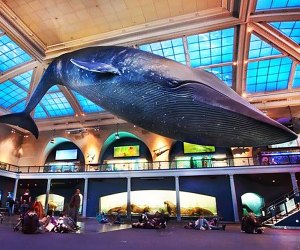Unseen Oceans: Explore Aquatic Wonders at New AMNH Exhibit
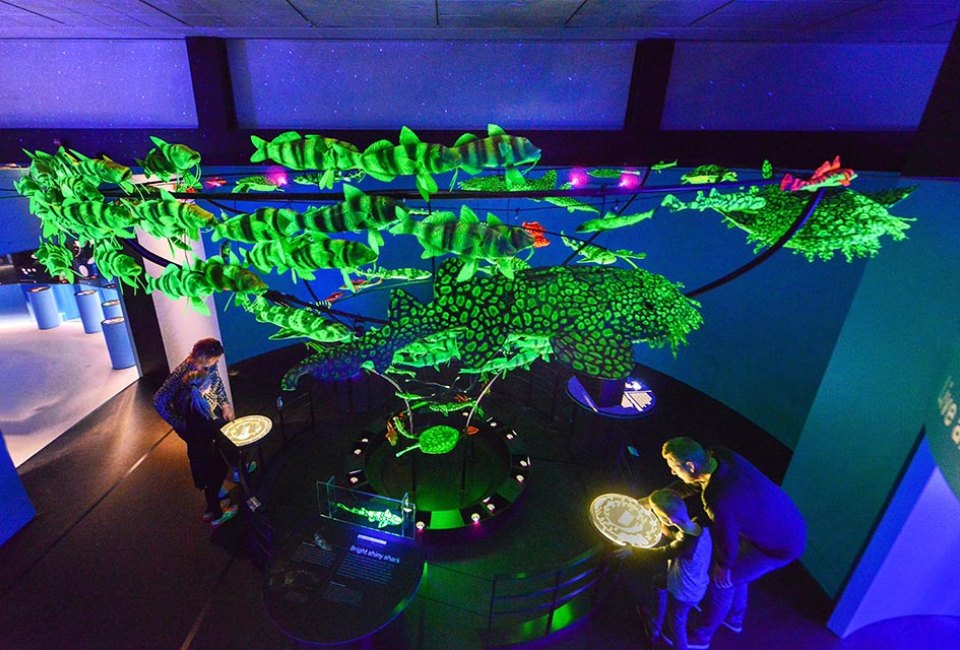
With last year's opening of National Geographic Encounter: Ocean Odyssey and the much-anticipated opening of Ocean Wonder: Sharks! at the New York Aquarium this summer, there seems to be a renewed interest in our oceans—and with good reason. Oceans cover 70 percent of the earth's surface and new science and technological advances have allowed marine explorers to learn more about our oceans than ever before.
The American Museum of Natural History is at the forefront of oceanic exploration and discovery, and its newest exhibit, Unseen Oceans, is designed to take visitors deep beneath the surface of the sea to a world scientists are just now beginning to understand—all presented in a series of family-friendly, easy to understand, visually stunning galleries.
OUR LATEST VIDEOS
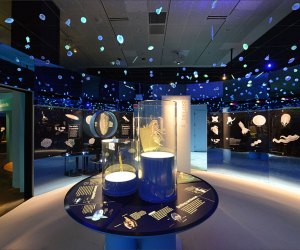
At the Planktonic Models visitors inspect larger than life planktonic species. Photo by R. Mickens/courtesy the museum
Located on the 4th floor of the American Museum of Natural History, Unseen Oceans serves as somewhat of an extension of its Milstein Hall of Ocean Life, one of the museum's most popular and beloved permanent exhibition halls. Visitors to Unseen Oceans are immediately drawn in by the sound of waves. A projection and supporting audio create a very real sensation of waves lapping at your feet. It's astonishing how real it looks so expect a bit of a bottleneck at the entrance.
RELATED: Restaurants for After Your Natural History Museum Visit in NYC
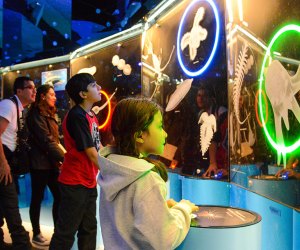
Visitors try to match adults from a variety of marine species to their planktonic forms. Photo by R. Mickens/courtesy the museum
Just past the entrance, visitors enter the first in a series of circular galleries, Mysterious Drifters. Here the focus is on plankton—microscopic organisms that drift in ocean waters and, as indicated in the gallery, are "as vital to life on Earth as rainforests or grasslands." Illuminated models of plankton hang from the ceiling, similar to a constellation of stars, and enlarged models of planktonic species are displayed throughout the gallery.
The next gallery, Secret Lives, focuses on bioflourescent sea animals. While bioluminescent animals create their light (similar to fireflies), bioflourescent animals absorb and emit light from their surroundings, glowing in stunning green, orange, and red. A beautiful spiral model in the center of this gallery reaches floor to ceiling and showcases an array of bioflourescent animals. There are more than 250 known species that have fluorescence, including chain catsharks. Never seen a chain catshark? No problem—this gallery features several lives ones in a tank! Seahorses are also on display and eels and scorpionfish are coming soon.
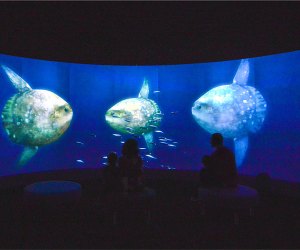
Visitors can stand side by side with some of the largest animals that inhabit our planet today. Photo by R. Mickens/courtesy the museum
Move to the next gallery, Encountering Giants, for a peek at some ocean giants. A large 180-degree screen spans most of this gallery and projects animations of stingrays, giant squid, manta rays, and blue whales.
Other galleries explore what we know of the ocean—and even what we don't. Did you know, for example, that only 10–15% of the sea floor has been accurately mapped? Visitors will learn what advances scientists have made and how technology is allowing them to explore previously uncharted territories with the use of special cameras, robotics, satellite monitoring, and more. When scientists want a firsthand look at an otherwise dangerous underwater environment, high-tech submersibles take them thousands of feet below the surface. A partial replica of a Triton—one of the submersibles used for underwater exploration—is on display, and makes for a great photo op.
RELATED: Night at the Museum: 7 NYC Museum and Zoo Sleepovers for Kids
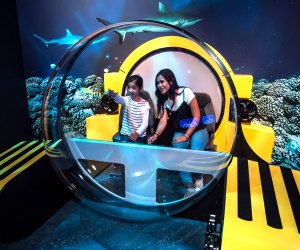
A partial replica of a Triton submersible provides visitors with the thrill of marine exploration. Photo by D. Finnin/courtesy the museum
Unseen Oceans also examines the effects of climate change, overfishing, wasteful practices, conservation efforts, and how we can preserve our oceans for generations to come. There are interactive elements in each of the galleries, amazing models of underwater life and microscopic organisms, and thoroughly engaging information everywhere you turn.
While this new exhibit is beautiful and informative, it isn't meant to replicate an aquarium visit. Instead, Unseen Oceans approaches the underwater world through a scientific lens, using technology to examine everything from microscopic organisms to ocean giants.
Unseen Oceans opens Monday, March 12, and is on view through Sunday, January 6, 2019. General Admission + One ticket is required ($28 for adults; $16.50 for children ages 2–12).
Top photo: Visitors examine the floor to ceiling array of fishes and turtles that are now known to biofluoresce. Photo by R. Mickens/courtesy the museum
Places featured in this article:
American Museum of Natural History
























